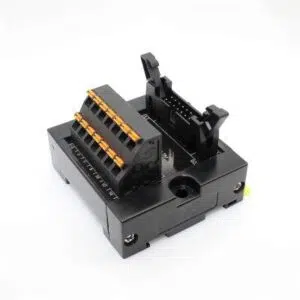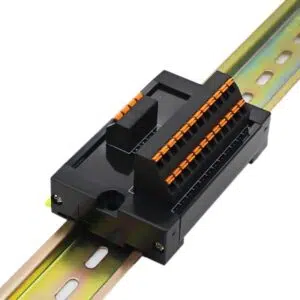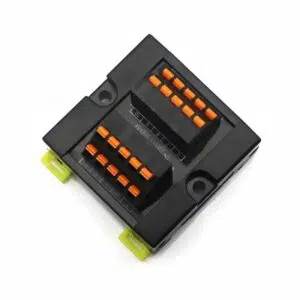For industrial applications where reliability is critical, steel DIN rail mounting clips are the go-to for heavy-duty needs. Unlike plastic brackets, which have limited load capacities, steel versions offer far greater mechanical strength, vibration resistance, and long-term durability. This is essential for tough environments like power cabinets or motor control centers.

This guide compares light-duty plastic brackets with heavy-duty steel DIN rail mounting brackets, looking at their load ratings, corrosion performance, and real-world uses. For practical applications where reliability is paramount, steel brackets ensure fail-safe mounting. Consider upgrading to high-strength steel clips like the DRG-09/10 series for unbeatable stability.
Part 1. DIN Rail Bracket Materials: Load Ratings & Applications
When choosing din rail mounting clips, material selection directly impacts load capacity and environmental suitability. Below is a quick-reference comparison of plastic, galvanized steel, and stainless steel brackets with their respective load ratings:
| Material | Max Load Capacity | Corrosion Resistance | Best For |
| Plastic | 15-20 kg | Moderate | Light-duty indoor use |
| Galvanized Steel | 30-50 kg | High | General industrial |
| Stainless Steel | 50-75 kg+ | Excellent | Harsh/outdoor environments |
For demanding applications with vibration or heavy components, steel brackets (especially stainless) provide unmatched durability. Always verify load requirements against your specific rail and mounting conditions.
Part 2. Vibration and Corrosion Resistance: Quick-Release Steel Clips vs Screw-Mounted DIN Rail Brackets
This comparative analysis evaluates the mechanical and environmental performance differentials between quick-release steel clips and screw fasteners in DIN rail applications. The following data-driven assessment examines vibration resistance, corrosion durability, and operational efficiency under standardized test conditions.
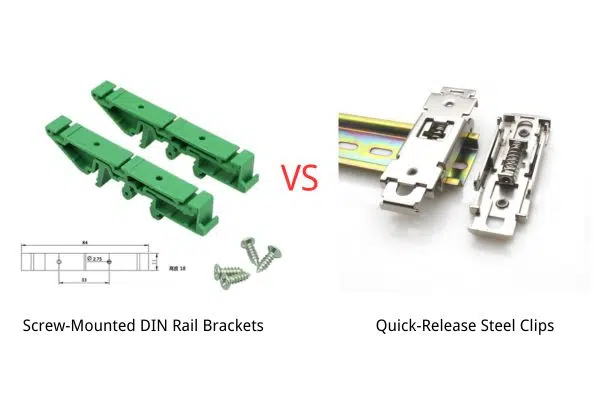
1. Vibration Resistance Performance
- Test Standard: IEC 60068-2-6 (5-10G vibration spectrum)
- Quick-release steel clips: Maintained secure mounting throughout 1000+ test cycles
- Threaded fasteners: Exhibited 0.5-1.2mm loosening displacement after 300 cycles
- Advantage: Spring-loaded clip mechanism effectively compensates for micro-vibrations (critical for transportation/mobile equipment applications)
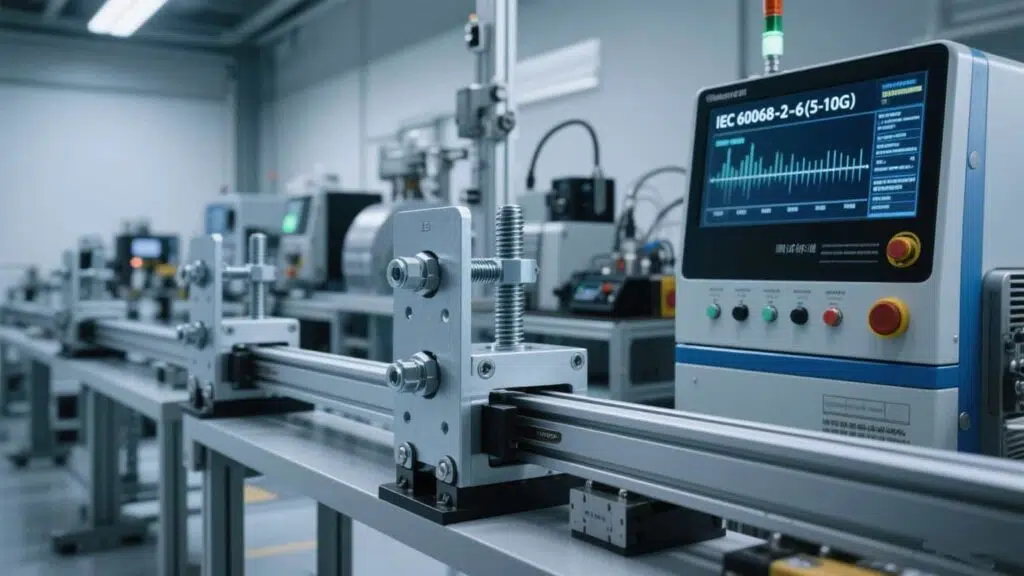
2. Corrosion Resistance Evaluation
- Test Standard: ISO 9227 neutral salt spray
- Stainless steel quick-release clips: No visible corrosion after 500 hours exposure
- Zinc-plated screws: Initial rust formation observed at 192 hours (±15)
- Field Correlation: Offshore wind turbine installations show 3.8x longer service life with stainless clips
3. Operational Efficiency Metrics
- Installation Time: 65% reduction vs. threaded fasteners
- Maintenance Accessibility: Tool-less operation enables 40% faster component replacement
For mission-critical applications requiring:
- Vibration stability (Class III per EN 50155)
- Corrosion resistance (C5-M category)
- Service efficiency
The quick-release DIN rail mounting system presents a technically superior alternative to conventional threaded solutions.
Part 3. Application Cases: Light- vs Heavy-Duty DIN Rail Mounting in Wind Turbine Systems
In wind energy applications, proper DIN rail bracket selection directly impacts system reliability. Our field studies reveal distinct usage patterns between pitch control cabinets and frequency converter enclosures:
1. Pitch Control Cabinets (Heavy-Duty)
Stainless steel DIN rail mounting clips demonstrate critical advantages in turbine pitch systems:
- Withstand 8-12G vibrations during emergency braking events
- Resist salt spray corrosion (5000+ hours in coastal installations)
- Support 60-75kg busbar assemblies without deformation
A Scandinavian wind farm reported 40% reduction in maintenance interventions after upgrading to heavy-duty stainless brackets (DRG-10 series).
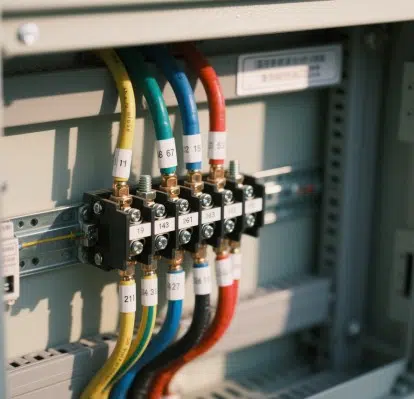
2. Frequency Converter Cabinets (Light/Medium-Duty)
- Galvanized steel brackets prove optimal for VFD installations: 25-40kg load capacity handles contactors and relays
- Powder-coated versions prevent electrolytic corrosion
- Quick-release clips enable 30% faster module replacements
In German onshore projects, galvanized solutions showed 100,000+ operation cycles without failure.
Selection Guidelines
- Pitch systems: Mandatory stainless steel heavy-duty brackets
- Converter cabinets: Galvanized steel (coastal) or engineering plastics (inland)
- Universal requirement: EN 60715 rail compatibility verification
Part 4. Four-Step Selection Methodology for DIN Rail Mounting Bracket
This part provides a systematic selection approach to DIN rail mounting bracket specification:
FIRST: Load Assessment
- Calculate total assembly weight (components + wiring)
- Apply 1.5x safety factor for dynamic environments
SECOND: Environmental Evaluation
- Corrosion risk level (ISO 12944 C1-C5 categories)
- Vibration/impact forces (IEC 61373 Class requirements)
THIRD: Material Selection Matrix
| Load Range | Indoor | Outdoor | Hazardous Area |
| <20kg | Plastic | Galv.Steel | Stainless Steel |
| >20kg | Galv.Steel | Stainless Steel | Stainless Steel |
FOUTH: Compliance Verification
- Confirm EN 60715 rail compatibility
- Validate UL/cUL listings for North American markets
*Note: For wind/power applications, always conduct FEM analysis when loads exceed 50kg*
Unsure which DIN rail mounting bracket to choose? Contact us, and our staff will gladly assist you with all your questions.
Part 5. FAQ—Choices between Light and Heavy-Duty Din Rail Mounting Clip
1. What are DIN Rail Mounting Brackets, and Why Do I Need to Choose Between Light and Heavy-Duty?
DIN rail mounting clips secure electrical components onto a DIN rail, a standardized metal track found in control cabinets. You need to choose between light and heavy-duty based on the weight and size of your components, plus any expected vibration or shock, to prevent equipment failure or safety issues.
2. How Do I Determine if I Need a Light-Duty or Heavy-Duty DIN Rail Bracket?
Consider the component’s weight and size first; light-duty suits smaller, lighter items, while heavy-duty is for larger, heavier ones. Also, factor in the degree of vibration or shock in the environment; heavy-duty brackets are essential for robust conditions.
3. What Are the Main Differences in Design and Material Between Light and Heavy-Duty DIN Rail Brackets?
Heavy-duty brackets are typically made from thicker, stronger metal or reinforced plastic, often featuring more robust clamping mechanisms and structural reinforcements. In contrast, light-duty brackets use thinner materials and simpler designs, prioritizing ease of installation for less demanding loads.
4. Besides Weight and Size, What Other Factors Should I Consider When Choosing Between Light and Heavy-Duty Brackets?
Beyond weight and size, consider the cost, as light-duty options are generally more economical. Also, think about the ease of installation and removal and whether the bracket needs to withstand specific environmental factors like extreme temperatures or chemicals.
5. What If I'm Still Unsure About My Choice? Are There Any Resources or Advice I Can Refer To?
If you’re unsure, always err on the side of caution and choose a heavy-duty bracket for added safety and reliability. You can also consult the component manufacturer’s data sheets or reach out to AOSI technical staff for the most sincere advice tailored to your specific application.
Conclusion
Choosing the right DIN rail mounting bracket is crucial for the longevity and safety of your electrical installations. Whether you’re prioritizing load capacity, vibration resistance, or corrosion resistance, understanding the differences between light and heavy-duty options is key.
Remember to assess your specific application’s demands, considering not just the weight of your components but also environmental factors and potential stresses. This knowledge is vital for selecting the appropriate DIN rail mounting clips.
Ready to upgrade or purchase your DIN rail mounting clips? Explore our products and discover reliable solutions for your needs.

